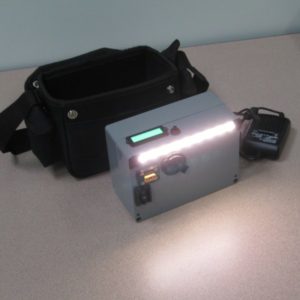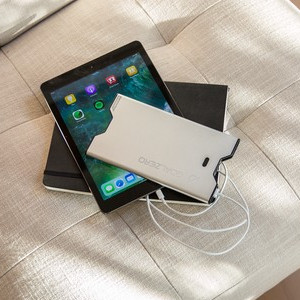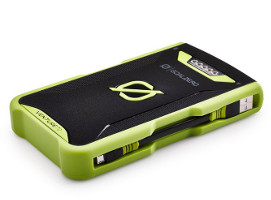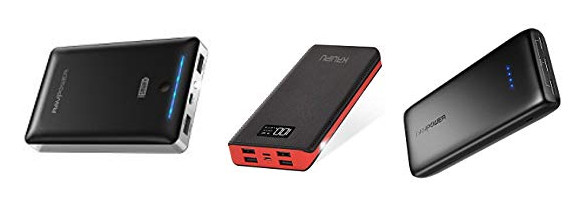There are a lot of “power banks” on the market that appear to have similar capability to the Half-Pint we build and sell, but in practical use they are significantly different. Here’s how to choose and things to watch out for:
 The Half-Pint is designed for semi-permanent installation in a remote village house where there is no power at all and it will be charged exclusively with solar every day for many years. It is bigger and heavier than an equivalent power bank, but will last 3 to 6 times longer than a power bank under continuous use due to the different lithium battery type (LiFePO4). It is also highly water resistant, and the battery can be replaced and other field repairs can be performed by a minimally trained technician. The solar panel comes on a 10 meter long cord, so the panel can be outside while you and your equipment are inside out of the sun and rain.
The Half-Pint is designed for semi-permanent installation in a remote village house where there is no power at all and it will be charged exclusively with solar every day for many years. It is bigger and heavier than an equivalent power bank, but will last 3 to 6 times longer than a power bank under continuous use due to the different lithium battery type (LiFePO4). It is also highly water resistant, and the battery can be replaced and other field repairs can be performed by a minimally trained technician. The solar panel comes on a 10 meter long cord, so the panel can be outside while you and your equipment are inside out of the sun and rain.
In contrast power banks are designed for temporary “on the go” use like business trips or camping. They can be a very small lightweight power system if you need extra power for  occasional trips off-grid. The most important limitation is they use LiPo cells with only 300-600 recharge cycles before they wear out and can not be repaired. If you’re not using them every day, they can last for years. Also the type of LiPo cells they typically use will leach Cobalt into the ground water (bad!) if tossed into the garbage pile and not recycled properly. A second very important limitation is the short cords with thin wires and connectors – Your power bank will need to be outside with the solar panel while charging, possibly exposed to rain, thieves and the local children if you aren’t there guarding it. Power banks are not repairable on the field; they are throw-away devices.
occasional trips off-grid. The most important limitation is they use LiPo cells with only 300-600 recharge cycles before they wear out and can not be repaired. If you’re not using them every day, they can last for years. Also the type of LiPo cells they typically use will leach Cobalt into the ground water (bad!) if tossed into the garbage pile and not recycled properly. A second very important limitation is the short cords with thin wires and connectors – Your power bank will need to be outside with the solar panel while charging, possibly exposed to rain, thieves and the local children if you aren’t there guarding it. Power banks are not repairable on the field; they are throw-away devices.
If the above power bank limitations aren’t a problem for you, here’s a list of things to consider when shopping power bank for solar use.
- Size – usually listed in Milliamp Hours (mAh) to make it sound huge. Divide by 1000 to get amp-hours, then multiply by 3.7 V to get watt-hours. e.g. “20000mAh” really means 20 Ah at 3.7 V = 74 Wh This is about the same capacity as a medium notebook computer battery. For reference smartphone batteries range from 5Wh to 12Wh, and 10” tablets tend to have batteries around 30Wh. Caution: If you want to take your lithium power bank on a commercial airplane it must be smaller than 29000mAh = 100Wh (100Wh is the official size limit)
- Input Jack and rate limit – Many power banks charge through a micro-usb port like on cell phones. This is limited to 5V and usually 1A or 2.1A. This is a serious bottleneck. Even at 2.1A you’re only getting 10.5 watts maximum into the power bank so even with an over-sized 30W solar panel it will take all day to get a full charge. These will work OK for a phone, but for bigger things like a tablet, notebook or several phones, you’ll want a power bank that can accept input directly from a 12V solar panel. (The raw output from a 12V panel can get as high as 21V with no load, so the input must be rated for up to 21V) Typically, the input will accept a small round barrel plug and you need to get a panel with a matching plug or adapter to fit. The input and output jacks are usually small and fragile and will not take rough treatment very well.
- Can it both charge and discharge at the same time? – Look for this. This is a very rare feature, but extremely helpful for tablets and a virtual necessity if charging something as large as a notebook computer from a power bank. This allows you to, at sunset, have a fully charged laptop battery and a fully charged power bank instead of a mostly dead laptop battery and a fully charged power bank. That’s a big difference.
- The cords on power banks can be confusing to some users. It may be possible to plug things together wrong resulting in things mysteriously not working. Have a good look at the cords and plugs and consider who will be using it.
- USB-C – Some Ultrabooks and laptops now charge over a USB-C port. The official specification for power distribution over USB-C is called “PD” They’re up to revision 3.0 now with multiple options in each revision that manufacturers may or may not implement. Because of the mishmash of specs, an aftermarket “USB-C” charger or power bank can be “PD 3.0” compliant, but still may charge slowly or not at all with your chosen computer. (And the cable you use is also important) Make sure you test your charger & cables with your computer before you hop on a plane and fly halfway around the world.
- Output Voltage – Most laptop computers need 19V DC to charge, each manufacturer using a unique hard-to-find plug. (Though some new ones can charge over USB-C, see above.) There are a few Power Banks that can supply the correct voltage and plug tips for you, but the number of hours per day you can run will depend on how power-hungry your laptop is and the size of your solar panel and power bank. See our article on how to choose a laptop for help estimating the power you will need.
- Output current – For smaller power banks which charge phones and tablets over USB, this can be a concern. Some will support only 1 amp output, which is very slow for a tablet or large smartphone. Some have two outputs, but can only do 2 A on one of them or one at a time. Some can do 2.1 A on the output, but only 1 A on the input making the input a bottleneck. Some say they do 2.1A but really can’t. Test before you take them on a trip.
Recommendations
 GoalZero’s “Venture” and “Sherpa” lines of power banks are very well made and specifically designed to run on solar. https://www.goalzero.com/ We can get them at a significant discount for you. Ask for a price check at power_systems@sil.org
GoalZero’s “Venture” and “Sherpa” lines of power banks are very well made and specifically designed to run on solar. https://www.goalzero.com/ We can get them at a significant discount for you. Ask for a price check at power_systems@sil.org
The folks at www.voltaicsystems.com have also  pulled together a line of good quality power banks very suitable for solar use at reasonably prices. I recommend you start shopping at these two sites.
pulled together a line of good quality power banks very suitable for solar use at reasonably prices. I recommend you start shopping at these two sites.
Both of the above companies offer solar panels that are very nice but a bit pricey. You can also make other less expensive 12V solar panels work with their power banks if you get the connectors right. Contact us if you need help with that. Just email power_systems@sil.org.

 GTIS Power and Communications Systems
GTIS Power and Communications Systems
